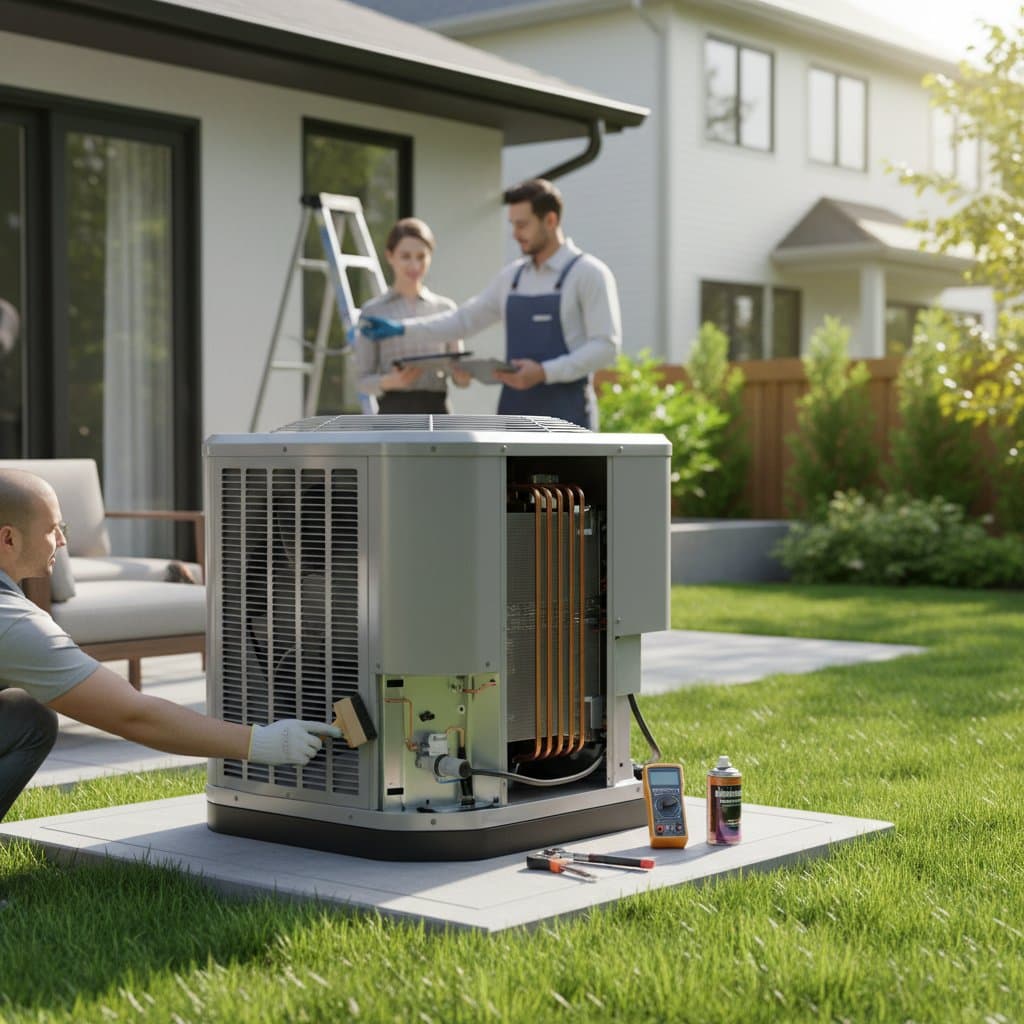Essential May AC Maintenance Checklist to Prevent Summer Breakdowns
The steady hum of an air conditioner provides reassurance as summer temperatures rise. However, that reliability can vanish abruptly if the unit malfunctions during the initial heat wave. Performing a straightforward maintenance checklist in May helps avert such failures, reduces energy consumption, and maintains comfortable indoor temperatures throughout the season. Homeowners can complete the majority of these procedures independently using basic tools and careful observation.
Begin with the Outdoor Condenser Unit
The outdoor condenser unit extracts heat from the interior space and requires unobstructed airflow to operate at peak efficiency.
Detailed Outdoor Unit Inspection
- Disconnect power at the breaker panel prior to any contact with the unit. Prioritize safety in all procedures.
- Remove debris from a two-foot perimeter surrounding the unit. Clear away leaves, twigs, and accumulated soil.
- Align bent fins using a specialized fin comb. This action ensures unrestricted passage of air across the coils.
- Rinse condenser coils with a low-pressure stream from a garden hose. Refrain from using forceful sprays that might bend the delicate fins.
- Examine the mounting pad under the unit. Verify that it remains level within one inch of variation. Add shims or fine gravel if adjustment proves necessary for stability.
Importance of Outdoor Maintenance
Obstructions to airflow diminish cooling effectiveness by as much as 15 percent. Thorough cleaning and proper leveling promote optimal function and alleviate stress on the compressor.
Examine and Replace the Air Filter
A dirty filter represents the primary reason for diminished cooling output. It impedes airflow, compelling the system to operate extended periods under increased strain.
- Standard filter dimensions: Residential units typically accommodate 16x20-inch, 20x25-inch, or 16x25-inch filters. Verify the exact specifications for the specific model.
- Recommended replacement interval: Change filters every 30 to 90 days, adjusting based on factors such as pet presence, dust levels, and daily occupancy.
- Appropriate filter efficiency: Select MERV 8 to MERV 11 ratings for typical households. Advanced ratings capture finer particles yet may hinder airflow in aging systems.
Extract the existing filter and assess its condition by observing the extent of discoloration or particulate accumulation. Install the replacement ensuring the directional arrow indicates flow toward the blower assembly.
Verify Thermostat Precision
Should the thermostat indicate 74 degrees Fahrenheit while the room feels noticeably warmer, inaccuracy likely exists. Position a separate digital thermometer adjacent to the device for a 10-minute period and record the readings for comparison.
- If discrepancies exceed two degrees, adjust the calibration or install a new unit.
- Evaluate the benefits of installing a programmable or smart thermostat. Such devices lower cooling expenses by up to 10 percent via intelligent scheduling features.
Position the thermostat away from direct sunlight exposure or heat sources like lamps to obtain accurate measurements.
Clean and Evaluate Indoor Elements
Accumulated dust within the air handler or furnace enclosure hampers overall performance. Access the interior by removing the service panel and inspect for the following:
- Dust on blower fan blades: Gently wipe surfaces with a moistened cloth to remove residues.
- Condensate drain pathway: Introduce one cup of distilled white vinegar into the drain port to inhibit algal development.
- Evaporator coil condition: Use a flashlight to confirm cleanliness. Professional intervention becomes essential if frost or oily residues appear.
Obstructions in the condensate line lead to water leakage that harms flooring and interior walls. Dedicate time to this inspection to safeguard the system.
Perform a Pre-Season System Test
- Cooled air must emerge from all vents within three minutes of activation.
- The exterior fan blade rotates steadily without unusual vibrations or noises.
- Indoor temperatures decrease by two to three degrees Fahrenheit over a 15-minute runtime.
Conduct this evaluation on a mild day to identify issues before peak demand arrives.
Pitfalls to Sidestep During Maintenance
- Overlooking filter replacements: A single neglected interval risks evaporator coil icing and system shutdowns.
- Employing excessive water pressure: Such methods deform fins and compromise heat exchange.
- Neglecting refrigerant piping: Verify that foam insulation encasing the copper lines remains undamaged. Renew any deteriorated segments promptly.
- Bypassing electrical breaker inspection: A recurring trip indicates potential motor overload or wiring faults requiring attention.
Indicators for Professional Service
Certain diagnostics exceed DIY capabilities and demand expertise from licensed HVAC technicians. Persistent warm airflow after maintenance, or frequent on-off cycling, signals needs such as refrigerant replenishment or circuit analysis. An annual professional inspection, priced between 100 and 200 dollars, encompasses deep coil sanitation, pressure evaluations, and component assessments.
Advanced Strategies for Optimal Cooling
- Maintain open interior doors and unobstructed vents to facilitate even air distribution.
- Vacuum register grilles on a monthly basis to eliminate settled dust.
- Integrate ceiling fans to enhance circulation, permitting a two-degree thermostat increase while preserving comfort levels.
- Arrange for ductwork cleaning every five to seven years, particularly beneficial for allergy sufferers.
- Renew thermostat batteries at the onset of the cooling period to ensure reliable operation.
Implement the Checklist for Lasting Reliability
Executing this May routine equips the air conditioning system for seamless summer performance. Invest a few hours now to eliminate the risk of urgent, high-cost interventions later. View the AC as a vital home asset deserving regular upkeep, and integrate this protocol into the yearly maintenance calendar for sustained efficiency.





